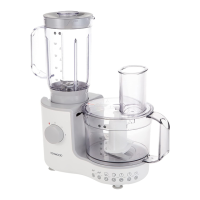citrus press
The citrus press is used to juice citrus fruit ie oranges, lemons,
l
imes and grapefruits.
1
Fit the bowl onto the processor. Add the strainer and turn
clockwise until the fin on the strainer aligns with the mark on the
p
rocessor body .
2
Attach the cone onto the drive shaft turning until it drops all the
way down .
3
Cut the fruit in half. Switch on and press the fruit onto the cone.
care & cleaning
●
A
lways switch off and unplug before cleaning.
●
Handle blades and cutting plates with care - they are extremely
sharp.
●
S
ome foods may discolour the plastic. This is perfectly normal
and won’t harm the plastic or affect the flavour of your food. Rub
with a cloth dipped in vegetable oil to remove the discolouration.
power unit
●
Wipe with a damp cloth, then dry. Ensure that the interlock area
is clear of food debris.
●
Don’t immerse the power unit in water.
●
Wrap excess cord around the bracket at the back of the
appliance.
liquidiser
1 Fill with warm water, fit the lid and filler cap, then switch on for
20-30 seconds.
2 Empty, then rinse. If it’s still dirty, use a brush.
3 Wipe, then leave to air-dry.
●
Do not immerse the liquidiser base in water.
all other parts
●
Wash by hand, then dry.
●
All attachments (except the liquidiser) can be washed on
the top rack of your dishwasher. A short low temperature
programme is recommended.
service & customer care
●
If the cord is damaged it must, for safety reasons, be replaced
by KENWOOD or an authorised KENWOOD repairer.
If you need help with:
●
using your appliance or
●
servicing, spare parts or repairs
Contact the shop where you purchased your appliance.
●
Designed and engineered by Kenwood in the UK.
●
Made in China.
I
MPORTANT INFORMATION FOR CORRECT DISPOSAL
OF THE PRODUCT IN ACCORDANCE WITH EC
DIRECTIVE 2002/96/EC.
A
t the end of its working life, the product must not be disposed of as
urban waste.
It must be taken to a special local authority differentiated waste
c
ollection centre or to a dealer providing this service.
Disposing of a household appliance separately avoids possible
n
egative consequences for the environment and health deriving
from inappropriate disposal and enables the constituent materials
to be recovered to obtain significant savings in energy and
resources. As a reminder of the need to dispose of household
appliances separately, the product is marked with a crossed-out
wheeled dustbin.
6

